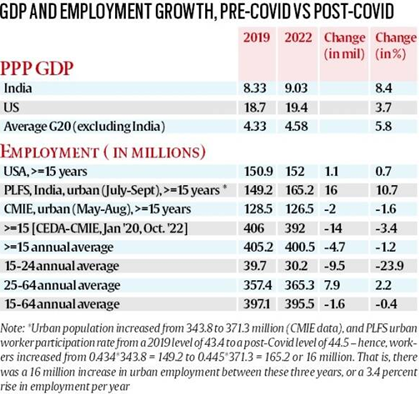Context
- The article expresses concern that non-availability of official data has allowed unofficial estimates about employment growth in India to flourish.
- It does this by comparing data from official and unofficial estimates and emphasizing the timely delivery of official statistics to address fears about the state of the Indian labour market.
Delays in Publishing Official Data Estimates
- Unfortunately, while employment is a very important policy concern, data in India is scarce.
- Profound changes in fertility, workforce, income generation and labour force participation of women are happening. But we don’t know because government data is being released on a delayed and irregular basis.
- In 2017-18, the NSO launched its periodic labour force survey (PLFS) with the promise that a timely quarterly employment series would be made available for urban areas, and an annual all-India series made available, after the completion of the July-June agricultural year.
- However, this promise has not been kept, despite India being amongst the top two economies in the world for computer software, and the leading economy in terms of financial payments technology.
Estimates from Latest PLFS
- The last available urban PLFS survey is for the period July-September 2022 and a quarterly bulletin with survey details and annual report for 2021-22 is awaited.
- The assessment related to the nature of employment expansion for urban areas can be concluded by comparing the worker-participation rate for July-September 2022, with the corresponding pre-Covid period in 2019.
- The urban employment increased by a healthy 10.7% in India in this period, a rate matching the exceptional comparative growth in GDP (from 3.74% in 2019 to more than 8% in 2022).

Examining Authenticity and Reliability of the Unofficial Data
- Non-availability of official data has allowed unofficial estimates about employment growth in India to flourish that depict confusing scenario related to employment and GDP.
- For example, an unofficial estimate in the form of a jobs bulletin jointly produced by Ashoka University’s Centre for Economic Data (CEDA) and Centre for Monitoring Indian Economy (CMIE).
- This CEDA-CMIE revealed in its study, “The Long Road to Recovery” that 14 million jobs (3.4% of the workforce) were lost between month of January 2020 and month of October 2022.
- The CEDA-CMIE conclusion that employment declined by 3.4% at the same time as GDP increased by 8.4% doesn’t seem plausible, as both numbers cannot be right.
- If both estimates are correct, then labour productivity in India in 2022 would be unrealistically high at 11.8% above the 2019 level.
Depicting Inaccuracies Related to CPHS-CMIE Data
- The World Bank, in its report on Indian poverty, first accepted and then explicitly rejected the CPHS-CMIE data and constructed its own data in order to derive results about consumption and poverty reduction in India.
- There are substantial reasons to doubt the credibility of the CPHS-CMIE data as demonstrated below:
- In stark contrast to the CEDA-CMIE claim of a loss of 14 million jobs between January 2020 and October 2022, the original CMIE data for the same age-group (>=15 years) for the calendar year 2019 and 2022 shows a job loss of only 4.7 million.
- This seems more aligned with the PLFS data for urban India that alone shows a gain of 16 million jobs between July-September period from 2019-20.
- The Economic Survey 2021-2022 had also indicated an increase of 4.75 crore in employment in 2019-2020 from 2018-2019.
- Also, the CPHS-CMIE female labour force participation rate (FLFPR) for 2019 is observed to be 11% and for 2022 it is reported to be even lower at 8.7%.
- This is contrary to PLFS estimates of FLFPR that are close to three times higher than the CMIE estimate, i.e., around 27% versus 9%.
- The latest CPHS-CMIE data for urban FLFPR is a low 6.3% (for September-December 2022).
- All these estimates are not only the lowest observed for India, but the lowest observed for any country, at any time, in recorded world history.
- The CPHS-CMIE estimates of urban male LFPR are also troublesome. For example, in 2022, the urban male LFPR of 68% from PLFS is almost 10% points higher than the CMIE estimate of 59.4%.
Conclusion
- The PLFS was launched in 2017 considering the importance of availability of labour force data at more frequent time intervals.
- However, the non-timely release of the PLFS data highlights the need for the government to introspect for delay in its own data which leads to delay in policy formulation and scheme implementation.
- Therefore, the prompt release of official data to reduce speculation about employment scenario in the country and bring authenticity related to various statistics published by the government, is the need of the hour.










